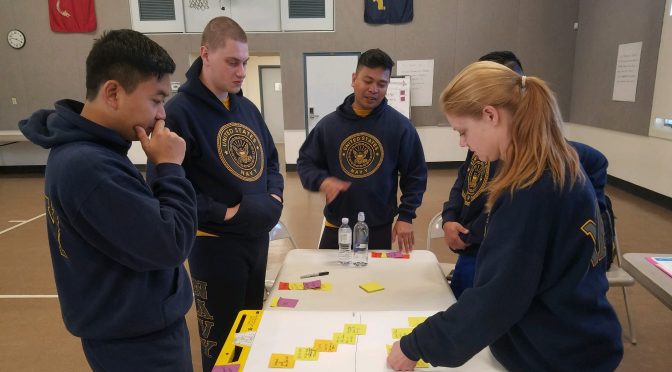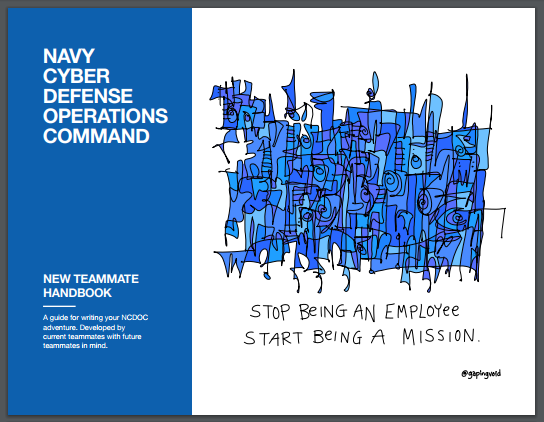How the Mad Foxes of Patrol Squadron FIVE are harnessing their most powerful resource – their people – in an effort to cut inefficiencies and improve productivity.
By Kenneth Flannery and Jared Wilhelm
The U.S. Military Academy’s Modern War Institute recently published a thorough primer by ML Cavanaugh on what it means to drive innovation in the military.1 The most important take away was the difference between the buzzword, “innovation,” and the people who actually do the dirty work of driving positive change within the force called, “defense entrepreneurs.” This series focuses on an operational U.S. Navy maritime patrol squadron full of defense entrepreneurs, and how their unit is taking the “innovation imperative” from on high and translating it to the deckplate level. Part 1 focused on the “Why? Who? And How?”; Part 2 reveals observed institutional barriers and challenges.
Deckplate Challenges
It often seems that the tasks most worth doing are the most difficult to achieve. Since beginning our innovation experiment, the squadron has been met with a variety of challenges to the implementation of our vision. Some of these obstacles are specific to the unique nature of the military, while others are more specific to the nature of large bureaucracies. Many challenges come from external sources that are largely outside of our control, while other challenges are self-inflicted.
One of our biggest hurdles has been thawing the “frozen middle.” This concept refers to the middle management contingent within the squadron that may be less eager to adopt new ways of doing things. Perhaps the most frustrating part about the “frozen middle” is that the very people who would benefit from embracing these changes are often the ones standing in the way. It is understandable and expected when organizations are resistant to an innovation developed outside of their ranks. All organizations have budgets to balance and bosses to answer to such that outside entities may be only a blip on their radar. For example, attempting to highlight the importance of one squadron in one community in one service of the Department of Defense can be understandably futile. More vexing are the people inside of one’s organization who seem to actively resist change at every opportunity. Frustrating as it may be, recruiting the members of the “frozen middle” is paramount for success. Buy-in from all organizational levels is required for original ideas to reach critical mass and become self-sustaining. Without support from the most resistant group, a new process will inevitably wither and die, even if it enjoys support from the top and bottom of an organization.
When VP-5 implemented the Innovation Department, the “frozen middle” quickly became apparent. The chief’s mess and the O-4 department heads, always looking out for undue risk to the Commanding Officer, were particularly averse to change. These groups bring a wealth of experience to the squadron and are absolutely crucial to the success or failure of our unit. However, that same hard-fought experience can sometimes saddle people with preconceived notions about “the way things are done” and other such attitudes which can stifle a creative environment.
Stopping new innovations from being implemented is often the path of least resistance for the frozen middle. VP-5 discovered that those who are averse to change will attempt to use their position of power as a roadblock. Often, it seems the frozen middle’s apprehension is rooted in a reluctance to put forth the effort necessary to change. Many of our innovations are designed to reduce the time and energy required to complete a task. However, at the onset, hard work is required to overcome the existing institutional inertia. Many times someone will cite comfortable catch-all words, such as “OPSEC,” or some unnamed instruction in an attempt to avoid putting up the innovation capital required for real change. However, it was the defense entrepreneur’s job to push past that initial roadblock. If a genuine concern exists, we may have to alter tack and reevaluate, but concerns raised about innovation must be the result of concrete analysis as opposed to institutional inertia.
Hitting the Wall
We were not always successful in overcoming these barriers. On more than one occasion the squadron had projects come to a full stop due to an inability to get through to the frozen middle. One project in particular was a fairly lofty goal of adding the maintenance program OOMA (Optimized Organizational Maintenance Activity) on to our PEMA (Portable Electronic Maintenance Aid) laptops.
Under the current system, writing a MAF (Maintenance Action Form) requires access to the OOMA program which is hosted on the Naval Aviation Logistics Command Management Information System (NALCOMIS). In turn, maintainers and aircrew alike are limited to writing MAFs at computers or laptops with hardwired connections to NMCI. This means writing MAFs during preflight or post-flight requires a trip to the hangar, eating up valuable time. This is a burdensome and antiquated system, which results in poorly written MAFs and decreased MAF participation at large.
Requiring NMCI access for writing MAFs also presents a problem when departing on or returning from deployment. There is often a period of several days before NMCI connectivity is established which means MAFs must be handwritten. Once NMCI connection is established these MAFs are retroactively input into OOMA, requiring a significant number of man hours.
Implementing OOMA on our PEMA laptops would be a simple way to streamline the maintenance action documentation process. PEMA laptops would be present on the aircraft, decreasing travel time and putting the feedback solution at the source of the problem. Optimizing this process would increase discrepancy documentation and create more detailed MAFs, facilitating faster resolutions to problems. Ultimately, OOMA on our PEMA laptops could eliminate some of the administrative and physical challenges that lead to wasted man hours and late takeoffs.
This project was led by a 2nd and 3rd Class Petty Officer with assistance from the Innovation Department. These intrepid innovators worked diligently in conjunction with the offices of Program Management Acquisition-290, SPAWAR, and the PEMA Fleet Support Team, but were ultimately told this project was not currently feasible. Part of the reason given had to do with the speed at which NAVAIR moves, which was colorfully described as a “turtle in a sea of peanut butter.” This is a common refrain we have heard time and again, and one that begs the question, “are these extended timelines actually necessary, or have we become so accustomed to them that they are now an accepted norm?”
Another instance where we ran into trouble was with a much smaller project. This time we were seeking permission to insert a Bluetooth USB device into an NMCI computer in order to display a rotating informational PowerPoint on a TV in the maintenance spaces. One of these TVs already existed in the squadron’s duty office, and we wanted to place one downstairs to address a maintenance concern about sometimes being left out of the loop.
We already knew Bluetooth devices were prohibited in NMCI computers so we reached out to the Information Assurance office for guidance about how to request a waiver, or if a waiver process even existed. In return, we received a curt e-mail informing us that USB devices were not allowed in NMCI computers, which was stated in the NMCI USB policy and also on the IA form everyone signs to gain access to NMCI computers. We responded to clarify, that indeed we already knew about the prohibition, but were asking if it possible to change the instruction. Ten months later we have yet to hear a response.
Innovation Breakthroughs
These experiences taught us that we needed a new way of approaching things that relied less on external forces and instead emphasized our own ability to create. One way VP-5 chose to thaw the “frozen middle” has been to outpace their skepticism. That is to say, rather than waiting for approval to pursue a particular initiative, we would simply go ahead and continue to work on a project until directed otherwise. The squadron would always inform the appropriate authorities and members of the chain of command, but we didn’t seek their explicit approval. When asking permission to do something, the answer was often “no,” even though there was rarely any substantiating reason for that “no.” Instead of asking, we started informing the Chain of Command of our projects and ideas. By doing this it seemed that we flipped the easy answer from “no” to “yes.” Employing this “Full Speed Ahead” tactic yielded many successes, including the creation of a new qualification program and incentivizing sailors to become innovators.
One hard won success for VP-5 was the development of the “P-8A Enlisted Engine Turns Program.” This program, long established in the P-3 community, allows a select number of enlisted maintenance personnel the opportunity to earn their “Enlisted Turn Operator” qualification. This qualification allows each operator to perform a variety of low-power engine operations for maintenance evolutions. Prior to the development of this program, these low-power turns required at least one pilot. This placed an unnecessary burden on the pilot cadre, which became particularly apparent when operating on detachment where extra pilots are few and far between.
To establish this program, VP-5 adopted a draft version of an Enlisted Turn Operator instruction from VP-30, the P-8A Fleet Replacement Squadron, and made it an official squadron instruction. The program now boasts an official curriculum consisting of written personnel qualification standards, simulator events, and aircraft events. To date, VP-5 has created four Enlisted Turn Operators, two of which had the distinction of being the first two P-8A Enlisted Turn Operators in the fleet. Throughout the process of establishing this program, the defense entrepreneurs clearly communicated their intentions up through the chain of command, and illustrated how they were mitigating the risk in this endeavor. The innovators gave the VP-5 chain of command the opportunity, but never a reason, to say “no.”
Another success for the VP-5 Innovation Department was incentivizing innovation. The Innovation Department first began to coalesce when the squadron was forward deployed to the 5th and 7th Fleet areas of responsibility. Throughout the six-month deployment the innovation movement seemed to be gaining steady momentum, and it was during this very early time that some of our most successful endeavors were developed. At the close of deployment in the spring of 2017, VP-5 shifted back stateside and continued to build this foundation. The Innovation Department was formally enshrined in a new instruction, detailing organizational roles and responsibilities, and we had regular innovation meetings with respectable showings. Unfortunately, interest and participation in the Innovation Department from the junior enlisted and junior officer ranks began to wane. At one meeting, attendance was limited to the box of doughnuts that had been brought for the no-show participants. This was a low point for the defense entrepreneurs. The lull in participation could have been due to a variety of factors, such as the return of family responsibilities, outside hobbies, and perhaps even an element of boredom. As time went on the new innovation initiative began to lose its luster.
Some of this can be expected in any organization trying to introduce a new culture, but some may be due to the career timing structure of the military. Sailors in VP-5 spend between two and five years in the squadron. Officers find themselves on the left side of that spectrum, while enlisted personnel are normally toward the right. To a newly minted lieutenant junior-grade or petty officer, a three to five year tour may seem daunting, but it can be a relatively short stay when all of the various qualifications and certifications that sailors must achieve during their time in the squadron are considered. Therefore, there may be little incentive for a sailor to invest their time and energy on an innovation that may not come to fruition before their tour is over. The temptation to accept the status quo to appease an immediate superior is too attractive for many. Although there will be those who naturally appear to think outside the box and resist the status quo, it is the responsibility of leadership to properly incentivize innovation.
VP-5 incentivized innovation by rewarding sailors who have contributed to innovation projects with awards and 96-hour liberty passes. While these may seem like superficial benefits, giving a sailor free time and recognition are the most immediate impact that a commanding officer can have on their subordinate’s life. It is necessary that more significant items, like promotions and advancements, are influenced at least in part by what a sailor has done to push the U.S. Navy into the 21st century.
Continuing the Fight
The concept of innovation is obviously not unique to the military. It is preached in boardrooms throughout the country as a way to cut costs, increase productivity, and generally rise above the competition. The companies that fail to adapt to changing environments often find themselves out of business. This same principle applies to the profession of arms. However, if we ever find ourselves “out of business” the opportunity to start over may not exist. Rarely are we afforded second chances to get it right. The time to find better ways to adapt and overcome is now.
Lieutenant Ken Flannery is a P-8A Poseidon Instructor Tactical Coordinator at Patrol Squadron FIVE (VP-5). He may be contacted at kenneth.flannery@navy.mil.
Lieutenant Commander Jared Wilhelm is the Operations Officer at Unmanned Patrol Squadron One Nine (VUP-19), a P-3C Orion Instructor Pilot, and a 2014 Department of Defense Olmsted Scholar. He may be contacted at jaredwilhelm@gmail.com.
CIMSEC is committed to keeping our content FREE FOREVER. Please consider donating to our annual campaign now so we can continue to provide free content.
References
[1] https://mwi.usma.edu/wear-pink-underwear-like-churchill-nine-principles-defense-entrepreneurship/
Featured Image: OAK HARBOR, Wash. (Oct. 21, 2016) Lt. Cmdr. Matt Olson, Patrol Squadron 30, right, talks Michael Watkins, a reporter with Whidbey News-Times and retired Navy Chief, through flight procedures in a P-8 simulator during a media availability on Naval Air Station Whidbey Island’s Ault Field. (U.S. Navy photo by Petty Officer 2nd Class John Hetherington/Released)









